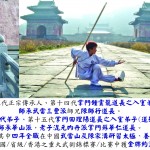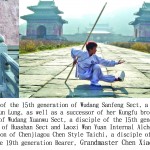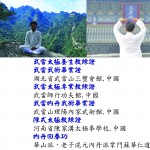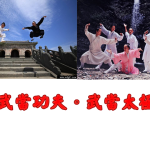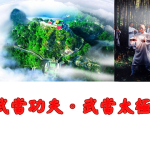(English) A6. Wudang Taichi – Taichi Board Sword (3 months)
A6. Wudang Taichi – Taichi Board Sword (3 months) Taichi Board Sword inherits Taichi Boxing’s characteristics of smooth-out, soft and nimble but also maintains the knifemanship of robustness and steadiness. It is good for both attacking and defense with well-stacked inner energy, coordination of forwarding/retreating and opening/closing movement, twining-head, as well as waist and leg
(English) A5. Wudang Taichi – Sanfeng Taichi Sword (4 months)
A5. Wudang Taichi – Sanfeng Taichi Sword (4 months) After inventing Taichi Boxing, Grand Master Zhang Sanfeng created the Taichi Sword, which has become the technique to be learned determinately by the masters generation after generation. While features Taichi Boxing’s characteristics of nimble, soft and continuing, it is elegant, unconventional and vivid. The practice requires
(English) A4. Wudang Taichi – The 108 Postures (6 months)
A4. Wudang Taichi – The 108 Postures (6 months) Tracing to the same origin of The 13 Postures and The 28 Postures, The 108 Postures is originated from Grand Master Zhang Sanfeng. Through watching the fight between the bird and snake, Grand Master comprehended the truth of reinforcement, neutralization, and independency between the softness and
(English) A3. Wudang Taichi – Taihe Boxing (3 months)
A3. Wudang Taichi – Taihe Boxing (3 months) Simple and short, Taihe Boxing has 22 postures and takes only 2-3 minutes to perform. Matching the twelve numbers of Dizhi (Earthly Branches of the Chinese Era), Taihe Boxing contains the circulation and transformation of Taichi, Yin-Yang, the five elements and the eight trigrams to assist the
(English) A1 Wudang Taichi – The 13 Postures (4 months)
A1 Wudang Taichi – The 13 Postures (4 months) As the most valuable of Wudang, the 13 Postures was created by Grand Master Sanfeng. While featuring in softness and continuing, it solves the attack along with steps and touch, harmonizes by being easy-going in manner but highly principled, practices qi, enhances the spirits, avoids the
政要名人都與太極拳親密接觸了,你還等什麼……?
政要名人都與太極拳親密接觸了,你還等什麼……? 為什麼太極拳運動受到世界人們的關注,請看下面的報導,緊跟政要名人的步伐,不落伍於時代,來吧,想政要名人一樣,開始你的太極之路! 太極拳作為中國武術瑰寶,一直受到世界各地人民喜愛。不同時期的政界人物也對太極推崇和喜愛有加。 武術家霍元甲和企業家農勁遜在上海創立精武體操會時,國父孫文題字“尚武精神”激勵國民。 文明其精神,野蠻其體魄。毛主席早在學生時代範就開始倡導的偉大民族精神!凡是能做到的如游泳、跑步打太極拳都應提倡! 周恩來總理上學期間曾跟一代形意拳大師韓慕俠學習形意拳。對於太極,周恩來這樣說過:太極拳是中國的一種優秀傳統文化,內涵十分豐富,充滿哲理,與中國傳統醫學有著血緣關係。學練太極拳是一項很好的健身運動,可以強身健體,可以防身自衛,也可以陶冶情操,是一種美的享受,還可以給人們生活帶來無限情趣和幸福,可以延年益壽。 ” 劉少奇最愛的運動之一就是打太極,他常常在中南海打拳。 陳毅元帥是太極拳的忠實擁泵。 時任中共中央副主席,國務院副總理鄧小平應日本國會議員訪華代表團團長、日本眾議院副議長三宅正一的邀請,欣然題下著名的“太極拳好” 1934年,蔣介石為楊澄甫《太極拳體用全書》題詞“鍛煉身心”。 親民的溫家寶總理不止一次與群眾共練太極,這不,正給德國總理默克爾秀太極柔力球! 李克強總理與印度總理莫迪天壇太極拳與瑜伽的宣傳盛會,把太極提升到新高度。 2009年,奧巴馬在眾議院國會咨文上,第一次將發源於中國的太極拳運動定義為世界上最完美的有氧運動!並倡導美國社會和公民大力推廣和學習太極拳。奧巴馬夫人在訪華期間更是身體力行學起了太極。 此外,前俄羅斯總統葉利欽因身體肥胖,練起了太極拳。堅持了幾個月之後,他逢人就說:我現在感覺好極了。英國王儲查爾斯也曾在參觀退伍士兵理療中心時對太極拳產生了極大興趣,並嘗試著學習一些招式。 如果喜歡已修習太極的方式修身養性、健身、防身的的話,請隨當代太極拳名家、中國武術七段、中國武術協會百名優秀考評員趙為民副教授修習太極心法!




